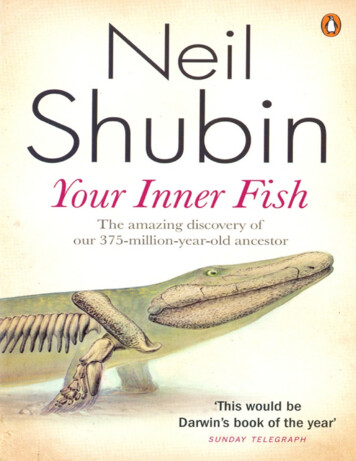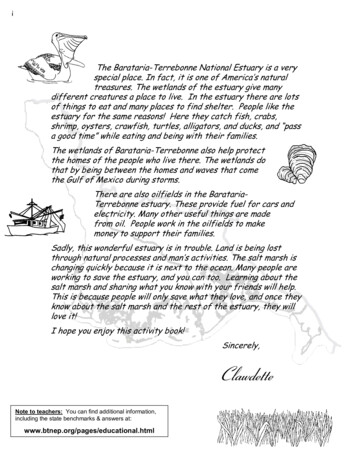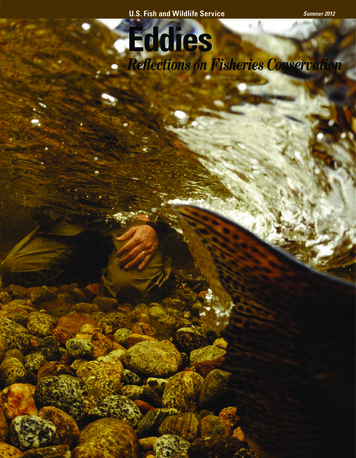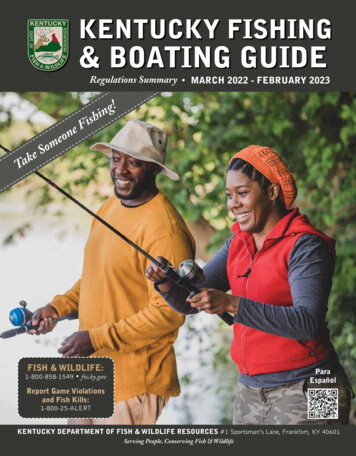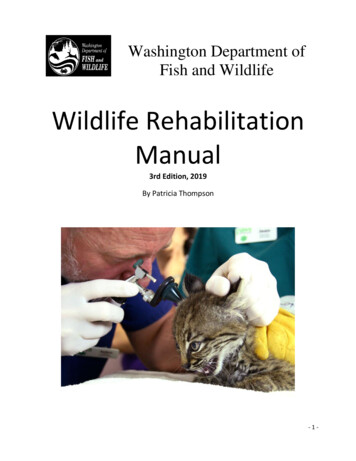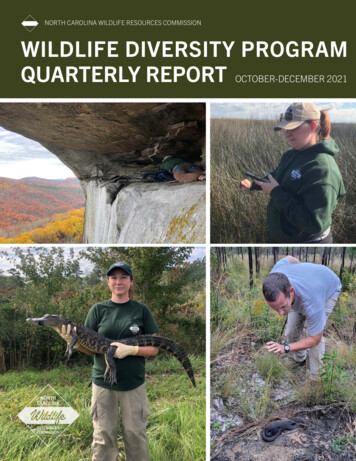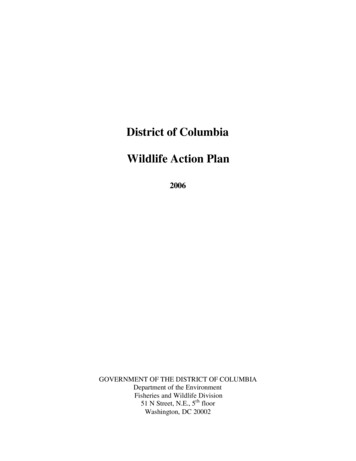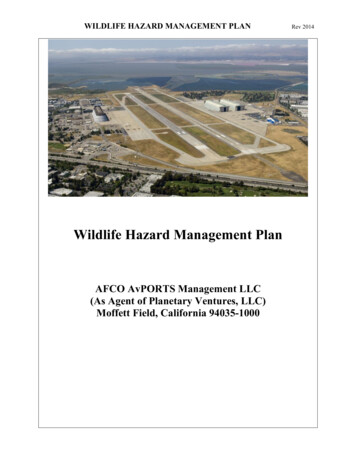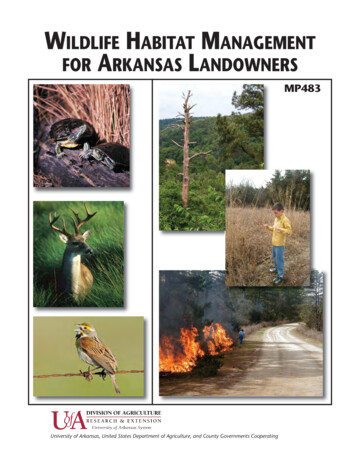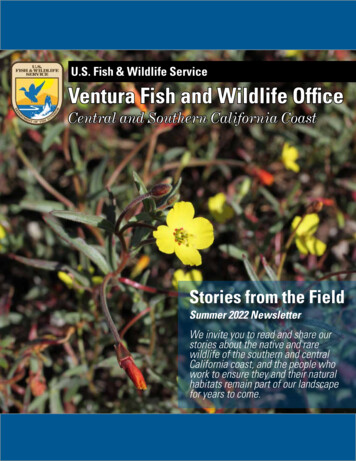
Transcription
U.S. Fish & Wildlife ServiceVentura Fish and Wildlife OfficeCentral and Southern California CoastStories from the FieldSummer 2022 NewsletterWe invite you to read and share ourstories about the native and rarewildlife of the southern and centralCalifornia coast, and the people whowork to ensure they and their naturalhabitats remain part of our landscapefor years to come.
conservation in actionConservation in ActionCollaborative conservation effortslead to downlisting of coastalCalifornia beach plantPlant once believed in danger ofextinction, no longer threatened in thewildThanks to decades of conservationefforts, the San Benito eveningprimrose, a small flowering plantnative to California, has been removedfrom the federal list of endangeredand threatened wildlife and plants dueto recovery. The U.S. Fish and WildlifeService listed the plant as threatenedunder the Endangered Species Act(ESA) in 1985 due to ongoing threatsof motorized recreation activities andcommercial mining operations.At the time of listing, the species wasdocumented in only nine locations ina small area of San Benito County,California. Annual surveys for thespecies have confirmed that the plantnow resides in more than 100 areasacross multiple watersheds in portionsof San Benito, Monterey and Fresnocounties. Learn more.Morro shoulderband snail. Photo courtesyof Dan DuganEndangered snail inches towardrecoveryA rare snail found only around LosOsos and Morro Bay along the centralCalifornia coast is crawling towardrecovery thanks to survey, habitatprotection and conservation effortswith local partners. We announcedthis February that the Morroshoulderband snail is no longer indanger of extinction, improving itsconservation status from endangeredto threatened under the EndangeredSpecies Act (ESA).“The Endangered Species Act is acatalyst for recovery, and we knowit’s working when we see specieslarge and small take steps towarddelisting,” said Cat Darst, AssistantField Supervisor for the U.S Fishand Wildlife Service in Ventura,Calif. “Thanks to city, county andstate efforts that include habitatprotection and increased surveying,Morro shoulderband snail numbersare now in the thousands rather thanhundreds.”The San Benito evening primrose is beingdelisted under the Endangered SpeciesAct. The plant occupies a goldilocks niche,surviving best in areas with nutrient poorsoils and a specific amount of disturbance.As a result, the San Benito eveningprimrose contributes to a primary trophiclevel in an environment where manyplants can’t survive.Credit: Ryan O’Dell/BLM1 / Ventura Fish and Wildlife Office 2022USFWS partners supporting thesnail’s recovery include the communityof Los Osos, private landownersand local biologists, as well as theCalifornia Department of Parks andRecreation, California Departmentof Fish and Wildlife, Morro CoastAudubon Society, Land Conservancyof San Luis Obispo and the County ofSan Luis Obispo. Learn more.This March, we announced thedownlisting of beach layia fromendangered to threatened underthe Endangered Species Act (ESA)due to substantial improvementsin the species’ status since listing in1992. As a result of years of collectiveconservation efforts of federal, state,local and private partners, this speciesis one step closer to full recovery.Beach layia is a succulent annual herbbelonging to the sunflower family.The plant grows on dry, exposedbeach sites spread across six isolateddune systems in coastal California.From north to south, there are 13populations of beach layia fromHumboldt County to VandenbergSpace Force Base in Santa BarbaraCounty.“Today’s action is the result of thecollaborative conservation effortsof many partners, including federal,state, local and private groups,” saidTanya Sommer, Field Supervisorof the Arcata Fish and WildlifeOffice. “While there is still work tobe done before the beach layia isfully recovered, with the continuedcommitment of these partners and thepublic I am sure we will get there.”Learn more.Beach layia. Credit: Dave Impert/USFWS
conservation in actionConservation in ActionCelebrating the history of island plantconservationCalifornia’s Channel Islands makeup an archipelago of eight islandsoff the coast of Southern California.Often referred to as “The Galapagosof North America,” their isolationcoupled with unique climate, soils, andtopography support a diverse rangeof flora and fauna, including manyrare and endemic plant species foundnowhere else on Earth.Take a visual journey through thehistory of plant conservation on thesemajestic islands in this interactiveArcGIS Story Map created byDaniel Cisneros, 2021 Kendra ChanDirectorate Fellow. Check out thestorymap.Santa Cruz Island dudleya. Photocourtesy of Santa Barbara BotanicGardenIsland barberry. Credit: Ken Niessen/USFWSSoft-leaved island paintbrush. Photocourtesy Kathryn McEachern/USGSWildlife scientists continue to seekcause of California brown pelicanillness and mortalityWe’re working with our partners atCalifornia Department of Fish andWildlife, local wildlife rehabilitationfacilities, and other state partners toassess an increase in California brownpelican illness and mortality along thesouthern and Central California coastin recent weeks. If you see an injuredor sick pelican, please contact yourlocal wildlife rehabilitation facility.For your and the birds’ safety, pleasedo not touch, attempt to feed, or takephotographs with the birds. CDFW,USFWS and partners will continue totrack this unusual event and we valuethe public’s interest and appreciate allefforts to report. Learn more aboutthis strange mortality event.2 / Ventura Fish and Wildlife Office 2022Brown pelican. Photo courtesy of Mike McCrary
our peopleour communityOur PeopleConnecting people with natureCat Darst is an FWS scholar!Join Hispanic Access FoundationInterns Fabiola and Fernando asthey show us the importance ofenvironmental conservation and teachus new facts about nature!Watch the videos.Assistant field supervisor andUSFWS Scholar Cat Darst caresabout species recovery, improvingdecision making, and conservationpolicy.Faces of the Fish and Wildlife ServiceMeet fish and wildlife biologistAndrew Dennhardt and officeassistant Ann Bliss in our latestFaces of the Fish and WildlifeService interviews!“Her favorite part of working forthe USFWS is the applicationof the best available science toEndangered Species Act decisions,”Cat explains. She believes that,“this is when the Service is atour best, doing the incrediblyimportant, science-based workof preventing extinction andpromoting recovery.” Read the fullstory.Andrew discusses his conservationheroes and his path to the U.S. Fishand Wildlife Service. Ann discusseshow an RV road trip put her downthe path to a career in conservationand how volunteering at a wildliferescue inspired her to make herown pollinator garden. Learn moreabout Andrew. Learn more aboutAnn.Celebrating women in scienceEvery year, we honor theinstrumental contributions ofremarkable women to our ultimatemission: the conservation andprotection of rare fish, wildlife,plants and their habitats for thecontinuing benefit of the Americanpeople. In this video series, you’llhear what inspired these women topursue careers in conservation, andwhat advice they have for youngwomen today. Watch the videos.3 / Ventura Fish and Wildlife Office 2022
field featsField FeatsPlover fencing installationRecovery efforts for species in SantaBarbara CountyWe’re working with Ventura AudubonSociety to install fencing along areasof Hollywood Beach in Oxnard tohelp Western snowy plovers thriveduring the breeding season! Thesefences are important because theyremind visitors to share the shorewith our local, native, and rare wildlife,especially during the nesting seasonwhen the birds and their nests aremost vulnerable! Don’t forget that we#sharetheshore with wildlife!We’re working with the La KretzCenter for California ConservationScience at UCLA and biologists with alocal environmental consulting groupto detect and recover California tigersalamander and vernal pool fairyshrimp in northern Santa BarbaraCounty!While out on a site visit, the groupinspected 2 vernal-pool locations,evaluating the ponds’ soil andhydrologic features and samplingthem for the presence of Californiatiger salamanders, vernal pool fairyshrimp, and other listed or at-riskspecies. The day’s visit demonstratedthe tremendous value of collaborativeconservation!Dr. Kathryn McEachern. Photo by USGS.Recovery champion announcedWildlife biologist Andrew Dennhardt helpsinstall plover fences. Credit: David Sherer/USFWSSigns that were put up along the ploverfences. Credit: Amy Hughes/USFWS4 / Ventura Fish and Wildlife Office 2022We announced Dr. KathrynMcEachern, research ecologist withthe U.S. Geological Survey, as therecipient of the U.S Fish and WildlifeService’s prestigious 2021 RecoveryChampion award for her leadershipin the recovery of threatened andendangered plants on California’sChannel Islands!“We cannot achieve our missionof endangered species recoverywithout the pivotal scientificresearch that underpinsconservation and managementactions for rare species,” saidSteve Henry, field supervisor of theU.S. Fish and Wildlife Service inVentura. “I am honored to presentDr. McEachern this nationalaward on behalf of our agencyfor her lifelong contributions toChannel Islands plant conservationand for her role in inspiring newgenerations of women scientists.”Inspecting a vernal pool. Credit: AndrewDennhardt/USFWSWorking with partners is important forconservation. Credit: Andrew Dennhardt/USFWS
field featsfield featsField FeatsGrand opening of the North CampusOpen Space Preserve with theUniversity of California Santa BarbaraWe’re thrilled to celebrate the GrandOpening of the North Campus OpenSpace Preserve with the University ofCalifornia Santa Barbara!“Coastal wetlands are a preciousresource that benefit people andwildlife. They buffer climate changeby creating tidal systems that adaptto sea level rise and reduce floodingby protecting communities fromstorm surge and retaining rainwater.Coastal wetlands support a myriadof rare and native species fromCalifornia red-legged frogs andCalifornia least terns to tidewatergobies and western snowy plovers,”said Steve Henry, field supervisor forthe U.S. Fish and Wildlife Servicein Ventura, Calif. “Devereux Sloughat the North Campus Open Spaceoffers pristine habitat to help movethese species closer to recovery whileproviding year-round educational andrecreational opportunities for peoplefrom all walks of life, from collegestudents to young families, becausenature is for everyone.”Ribbon cutting ceremony. Photo courtesy of UCSBVentura marsh milk-vetch. Credit: ColleenGrant/USFWSNorth Campus Open Space Preserve.Credit: Colleen Grant/USFWSMyrtle Pond. Credit: Colleen Grant/USFWSRemoving bulrush at Myrtle Pond. Credit:Colleen Grant/USFWSRestoring La Graciosa thistle at MyrtlePondWildlife biologists Colleen Grant andDeb Kirkland and botanist KristieScarazzo have been working with theThe Land Conservancy of San LuisObispo County to remove bulrush atMyrtle Pond in the Guadalupe NipomoDunes Complex!This will prevent further overgrowthand loss of open water habitat,benefitting the federally protected LaGraciosa thistle and California redlegged frog! LCSLO is the best andwe love working with them!5 / Ventura Fish and Wildlife Office 2022
our 2021 year in reviewOur 2021 Year in ReviewTake a look back at our 2021 Year in ReviewDespite these trying times, the Ventura FWO mission holds fast: to conserve and recover rare fish,wildlife, and plant communities across the Southern and Central California coast from our beautifulcoastal dune and sagebrush ecosystems to the rugged terrain of our chaparral and oak woodlands andforests.Buoyed by the Endangered Species Act, one of the nation’s foremost wildlife conservation laws, weworked with partners this year to find innovative strategies to protect ecosystems that benefit societyas a whole. Learn more about our work in 2021 in our Year in Review magazine and video.Visit us online!The Ventura Fish and Wildlife Officehas launched its new website. Forthe latest information and to sign upto receive our Stories from the Fieldnewsletter, please visit us at e or on Facebook at https://www.facebook.com/VenturaFWO.6 / Ventura Fish and Wildlife Office 2022
U.S. Fish & Wildlife ServiceVentura Fish and Wildlife OfficePublic Affairs Division2493 Portola Road, Suite BVentura, CA 93003805/644 1766https://www.fws.gov/venturaJune 2022We honor the beauty that is found in every unique individual and celebrate our shared diversity.Illustration of rare plants that we work to conserve and protect along the Southernand Central California coast by Karen Sinclair/USFWS
California least terns to tidewater gobies and western snowy plovers," said Steve Henry, field supervisor for the U.S. Fish and Wildlife Service in Ventura, Calif. "Devereux Slough at the North Campus Open Space offers pristine habitat to help move these species closer to recovery while providing year-round educational and
